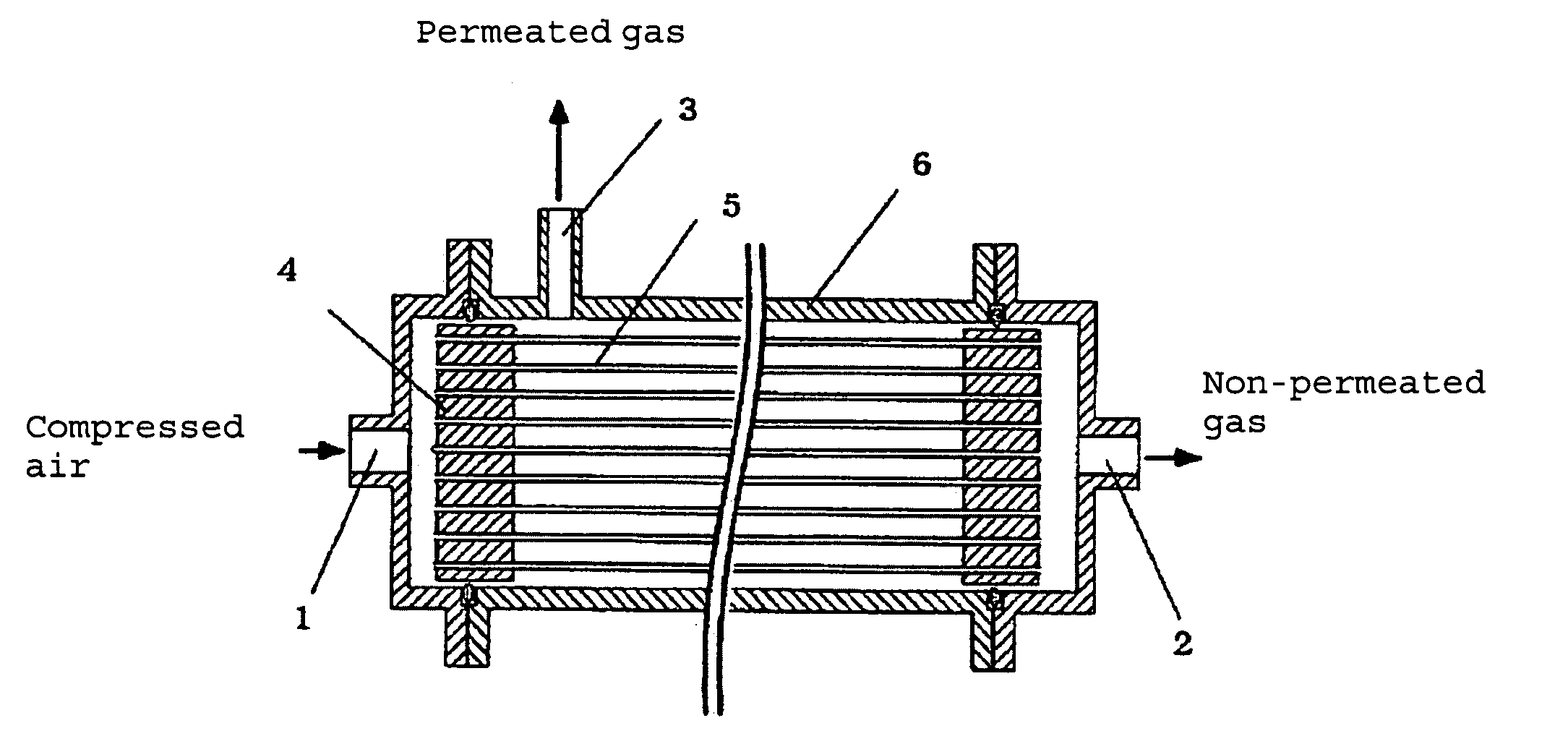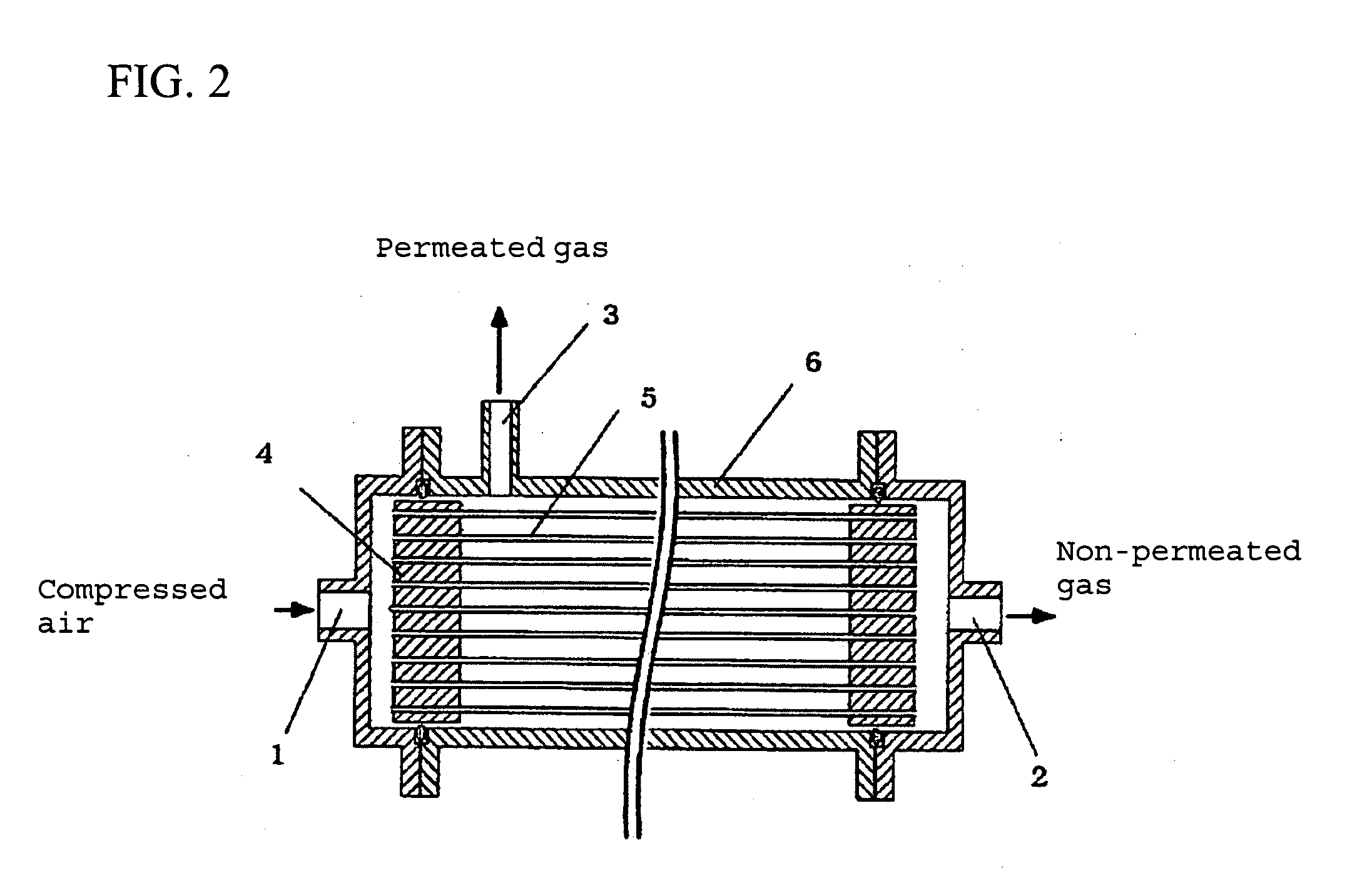Asymmetric hollow-fiber gas separation membrane, gas separation method and gas separation membrane module
a gas separation membrane and asymmetric technology, applied in the direction of membranes, separation processes, dispersed particle separation, etc., can solve the problem that the mechanical strength of the membrane still has room for improvement, and achieve the effect of sufficient mechanical strength
- Summary
- Abstract
- Description
- Claims
- Application Information
AI Technical Summary
Benefits of technology
Problems solved by technology
Method used
Image
Examples
example 1
[0086] In a separable flask, 8.21 g of 3,3′,4,4′-biphenyltetracarboxylic acid dianhydride (hereinafter, abbreviated as s-BPDA in some cases), 11.02 g of 2,2′-bis(3,4-dicarboxyphenyl) hexafluoropropane dianhydride (hereinafter, abbreviated as 6FDA in some cases), 7.37 g of dimethyl-3,7-diamino-dibenzothiophene-5,5-dioxide (hereinafter, abbreviated as TSN in some cases), and 8.65 g of 3,3′-5,5′-tetrachloro-4,4′-diaminodiphenyl (hereinafter, abbreviated as TCB in some cases) (1.020 parts by mol of diamine with respect to 1 part by mol of acid dianhydride.) were polymerized in the presence of 163 g of PCP serving as a solvent at 190° C. for 20 hours to obtain a polyimide solution, which had a polyimide polymerization degree of 44. To the polyimide solution, 2.03 g of pyromellitic acid dianhydride (hereinafter, abbreviated as PMDA in some cases), 1.30 g of TSN, and 1.53 g of TCB were added with 22 g of PCP serving as a solvent. The resulting mixed solution of multi-component polyimide wa...
example 2
[0093] In a separable flask, 9.12 g of s-BPDA, 11.02 g of 6FDA, 7.81 g of TSN, and 9.16 g of TCB were polymerized in the presence of 172 g of PCP serving as a solvent at 190° C. for 20 hours to obtain a polyimide solution, which had a polyimide polymerization degree of 57. To the polyimide solution, 1.35 g of PMDA, 0.87 g of TSN, and 1.02 g of TCB were added with 14 g of PCP serving as a solvent. The resulting mixed solution of multi-component polyimide was further polymerized and imidized at 190° C. for 18 hours to obtain a polyimide solution having a polyimide polymerization degree of 63, a rotational viscosity of 1953 poises, and a polymer concentration of 17 wt %. (The total source material composition: 1.020 parts by mol of diamine with respect to 1 part by mol of acid dianhydride.)
[0094] A hollow-fiber membrane was produced from the mixed solution of multi-component polyimide in accordance with the aforementioned method for producing an asymmetric hollow-fiber membrane. The g...
example 3
[0096] In a separable flask, 8.21 g of s-BPDA, 2.03 g of PMDA, 5.20 g of TSN, and 6.11 g of TCB were polymerized in the presence of 99 g of PCP serving as a solvent at 190° C. for 17 hours to obtain a polyimide solution, which had a polyimide polymerization degree of 88. To the polyimide solution, 11.02 g of 6FDA, 3.47 g of TSN, and 4.07 g of TCB were added with 86 g of PCP serving as a solvent. The resulting mixed solution of multi-component polyimide was further polymerized and imidized at 190° C. for 12 hours to obtain a polyimide solution having a polyimide polymerization degree of 69, a rotational viscosity of 1600 poises, and a polymer concentration of 17 wt %. (The total source material composition: 1.020 parts by mol of diamine with respect to 1 part by mol of acid dianhydride.)
[0097] A hollow-fiber membrane was produced from the mixed solution of multi-component polyimide in accordance with the aforementioned method for producing an asymmetric hollow-fiber membrane. The ga...
PUM
| Property | Measurement | Unit |
|---|---|---|
| Temperature | aaaaa | aaaaa |
| Temperature | aaaaa | aaaaa |
| Temperature | aaaaa | aaaaa |
Abstract
Description
Claims
Application Information
 Login to View More
Login to View More - R&D
- Intellectual Property
- Life Sciences
- Materials
- Tech Scout
- Unparalleled Data Quality
- Higher Quality Content
- 60% Fewer Hallucinations
Browse by: Latest US Patents, China's latest patents, Technical Efficacy Thesaurus, Application Domain, Technology Topic, Popular Technical Reports.
© 2025 PatSnap. All rights reserved.Legal|Privacy policy|Modern Slavery Act Transparency Statement|Sitemap|About US| Contact US: help@patsnap.com



